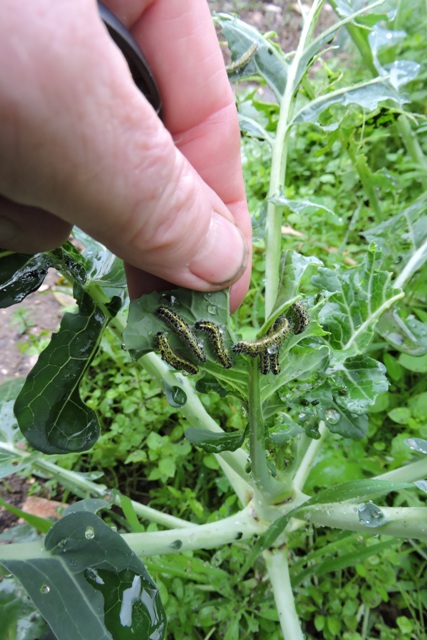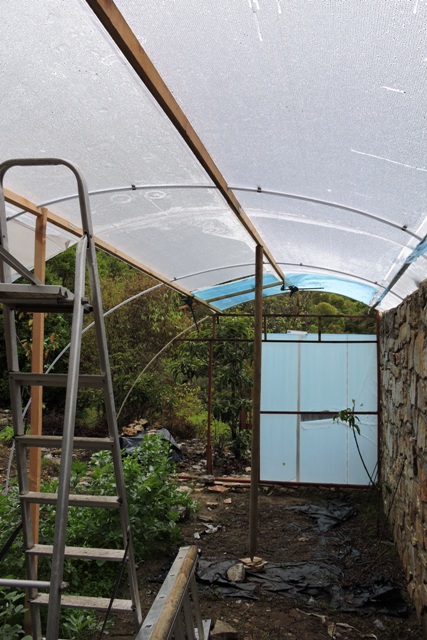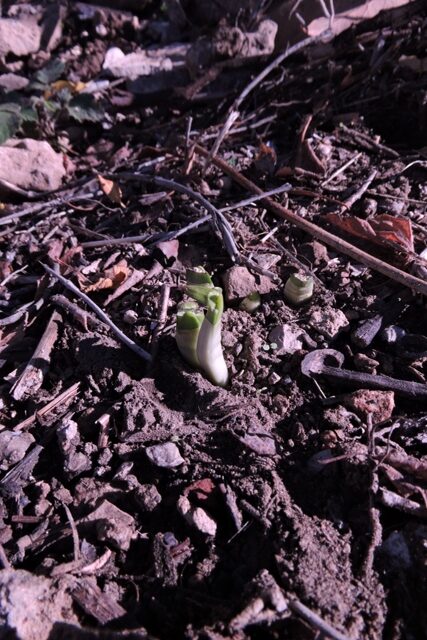I’ve succumbed
This week: I’ve succumbed; Two days short; Friends visiting; Another weekend approacheth; VoCC;

The autumn rains have finally arrived.
This week we have has a very welcome 78 mm or 78 litres of rain per square meter.
This does of course mean that I have not spent very much time outside. This is because I don’t want to become corroded!
We seem to have swung from summer to winter in one move, which has meant that I am not ready. I have a lot of bulbs which need planting, but the conditions have not been right.
A couple of weeks ago everything was way, way too dry and now the soil is too wet and sticky. It’s my clay loam soil’s fault…
One thing I did discover this week is that my winter Broccoli is being eaten alive by Large White, Pieris brassicae, butterfly caterpillars.

Their Latin name says everything: they feed on brassica plants and quickly skeletonise tasty young leaves.

By my count, this is the fourth brood of eggs which have been laid this year. Two broods is normal, three unusual, but four??
I’ve succumbed
The week began with more (and much needed) rain and cooler temperatures. Gone are the twenty two to twenty five degrees we were enjoying just two weeks ago.
Tigger, the runt of the kitten litter, now a young adult came in really wet and I realised the dining room actually felt cold.
Outside the temperature had fallen with the rain to +13ºC, and inside it felt colder, as so often happens at certain times of year.
I had already cleaned the tubular pipes of the air heater above the wood stove, then run a scraper through the flue pipes to remove the aggregated carbonised remains of last years burnt wood.

In all I recovered a half bucket of debris, so that should improve the flu draught. There was no soot, just glossy black carbon.
I always make a point in the spring of laying a fire in the grate, after the inside of the wood stove has been cleaned, so that all that is needed is a match.
To be fair, as the rainy afternoon had worn on, on Sunday and I was working at the computer, I had felt a slight chill too.
At one point during the afternoon I had checked the indoor and outdoor temperatures. Inside it was 16ºC.
The fire lit instantly and I watched and waited as the water in the internal jacket heated, to make sure the circulation pump cut in.
Exactly on cue, as the water temperature reached 40ºC, the pump started. That is always a good sign and means there is one less problem to fix.
As the temperature built, I walked round and checked the radiators. They were all beginning to feel warm to the touch, so another good sign.
As one happy feline sat in front of the fire, cleaning himself, I did reflect on what it is that our feline friends think of when their significant human is doing ‘things’.

You can see in their eyes and the tilt of their head that there is something going on in their grey matter. That is of course besides thinking of food…
Sitting down in front of the computer screen once again, the chill had vanished. I re-checked the thermometer and it was 17.5º, so only 1.5 degrees more, but my study temperature felt completely different.
I think I have found my comfort level setting, even if I have succumbed now to lighting the nightly fire in the wood stove.
Two days short
I almost finished the polytunnel this week, except the “rain stopped play”. I only needed two fine days…
I’m not a person who gives in to anything lightly, so this project has been a challenge.
I am really not sure what has changed between design and completion, but what I thought would be an easy task, to assemble the roof panels has proved exceptionally challenging.
There was a sudden realisation though, when I discovered that the panels are actually from different manufacturers and hence are ever so slightly different sizes.
Some are 6 mm in thickness and some are 5 mm. This fact alone may account for why some panels seem to fit into the joining strip more easily than others.
Waking early one morning, I had a ‘light bulb’ moment.
Part of the difficulty has been the size of the sheets and my arms not being long enough to hold, push and keep the sheets straight, all at the same time.
I had the idea to make a tool from some wooden offcuts, which I could clamp to the roof supports and then screw a second “hand” at the other end, to hold the sheet in position, while I manoeuvred it into the joint strip.

This really is straight out of the “Heath-Robinson” tool manual (as sold by the Heath Robinson Museum). With just three pieces of wood and two screws later and I had a working prototype and an extra pair of hands.
This tool worked and when it hasn’t been raining, I have managed to get almost all the roof panels into place and bolted down. The problem has been that there have not been many hours when the wet stuff hasn’t been falling.
I’m not complaining, after six months with almost no rain, we need all we can get. Just not this week (or next) please! Just two sunny days will do…
Friends visiting
I took a day off this week to visit Split. I’m pleased to say that Thursday was the best day of the week for weather.
Some friends from Abu Dhabi were visiting Split on their way to Greece, so it was a chance to meet and catch up.
As usual I was up at 4am, to catch the first ferry to the mainland.
On arrival I did a very early shop at Lidl, which is the only place I have found where you can buy Stollen.

Lidl being a German company, imports a lot of things from Germany, and of course Stollen is a German Christmas delicacy.
My friends have stayed in Split before, so have done the “tourist thing” in the old town, looking at Diocletian’s Palace, the old city walls etc.. So on Thursday there was a chance to do something different.
First stop was the City Centre One shopping mall for a nice coffee and piece of smokva cheesecake (I need to try making one!), then on to the Jadro Garden Centre next door.
This garden centre is one of those really interesting places where you can wander around all areas, including the large green houses where all next year’s plant cuttings are being grown.
There were row upon row of all kinds of cuttings, done in the old fashioned way rather than sterile Micropropagation.
But this nonsterile propagation method does mean that visitors can wander round to look at the process’s taking place.
Outside we looked at the huge old Olive trees, in giant plastic tubs, probably 50 or more years old and at prices starting at €5,500 each; the five meter Mediterranean Black Pines and a range of nice plants from Agapanthus and Canna Tropicana, through to Zinnias.
I came away with a red Firecracker plant, Russelia equisetiformis, something I have been going to get for the garden for a while.

This is a drought tolerant weeping perennial, two metre tall shrub, of irregular habit that originates from Mexico.
The scarlet flowers appear along the length of the long stems and are a rich nectar source for insects and pollinators.

So the day was definately a nice break. Thank you for calling….

Another weekend approacheth
Friday was another wet day.
I was watching bands of rain sweep through from the west on the rainfall radar.

As it seemed likely the there would be a break after lunch, I prepared to try and do as much as possible outside before dusk.
I had also seen that Saturday morning looked like being wet too, so “time was of the essence”.
I had spent the rainy morning getting things ready, cutting timber and some polycarbonate panels to size.

As the rain stopped I was out in the orchard and quickly fitted one panel of the polytunnel roof. I bolted it down to make sure it was secure and then marked another sheet for cutting.

I could hear thunder in the distance and the clouds to the west were growing darker by the minute, so I decided to pack my tools up.
As I was moving the steps under the completed part of the roof the heavens opened as a thunderstorm arrived.
The storm had passed within an hour, after depositing almost 25 mm of rain. This made everything exceedingly wet.

I started to fit a second panel but the light was also starting to fade. Because of the rain I was struggling to grip the wet panels.
Silicone spray really helps ease sheets into the grip strips, but in the rain….!
So with some regret I fixed the panel in place with clamps. This was in case there was any wind and left it for another day.
Between showers on Saturday I was able to fix it permanently.
VoCC – Velocity of Climate Change
We have moved beyond “Climate Change”, the changes to local climatic conditions caused by changes in the earth’s upper atmosphere, to “Climate Breakdown”.
This is where long established patterns of weather, heat and cold, wet and dry, are very different to those experienced, even within living memory.
I was interested to read a scientific paper published in Nature magazine, called the Velocity of Climate Change this week. This has been shortened to VoCC.
The article was published 13 years ago in December 2009. The writers had calculated the rates of change of plants and animals moving away from the equator.
To escape the changes in climate, they estimated that this was happening at between 0.8km and 1.26km a year. That is more than 3 meters every day.
The variation is seen in several different topographical zones.
These are between low/sea level and mountainous zones in the sub-tropical regions (lowest rate of change), to savannahs, mangrove swamps and dessert areas where the change is the highest.
This week more than 100 Pallid Swifts, Apus pallidus, have been seen in the eastern UK. This is because of the warm autumnal weather.
In the summer Bee Eaters have bred successfully in East Anglia for the first time.

Pallid Swifts were only first seen in the UK in 1978 and are usually never present this late in the year.
They are a species which nests across a broad swathe of the Mediterranean and North Atlantic Islands. The birds winter in sub-Saharan Africa.
Ornithologists have fitted Pallid Swifts with satellite tags at their nest sites in Gibraltar, to track the birds annual migrations.

All living species, including humans, must adapt to climate breakdown or move. There is a growing body of evidence that avian species are moving further north.
However therein lies a problem. It is easy for birds like the Pallid Swifts to change their migration pattern, but there may be no food where they arrive.
Or it may be the wrong food for migrants like butterflies and moths to lay their eggs on.
But plants can’t just up roots and move. They spread by their seeds finding a suitable habitat.
I had an interesting conversation with my bank manager this week about olives and olive oil.
He has close to 200 olive trees and usually harvests over 1.5 metric tonnes of fruit. This quantity usually gives a 10% to 12% yield, or say 11 litres of oil per 100 kilogrammes of olives.
This year he thinks he will be lucky to harvest 600 kilogrammes, so only a third of normal.
However in the olives he has already harvested, he is getting a 22% yield, double the normal and it is very good quality oil too.
The Velocity of Climate Change, is the rate at which something moves over the Earth’s surface to maintain constant climatic conditions. However this is a measure of change, not of the impact the change will have.
Many species of flora are not able to adjust and advance in the way birds and insects can. There are huge gaps in the scientific knowledge and understanding which research is racing to understand and fill.
This week I have Narcissi bulb shoots between 4 cm and 7 cm tall. They are usually in flower around Christmas or New Year but it seems they are keeping up with the changing climate in Dol and will flower earlier.

My concern is for other species, which are the food for spring migrants.
Unless everything advances at the same rate, then some species will find their preferred foods have already been and gone. Or they have not yet advanced with the seasons so are equally unavailable
We should all be very worried! NCG
One Response
John Bailey
I agree Norman. We should all be worried by changes to climate. We have delphiniums now coming out in flower. The second time this year. Unheard of a few years ago.